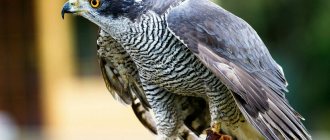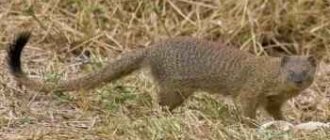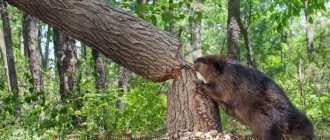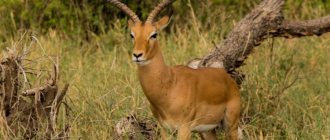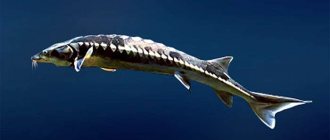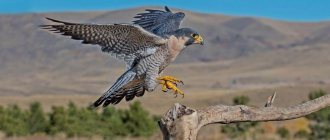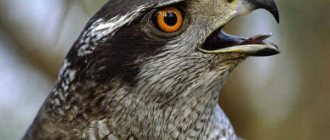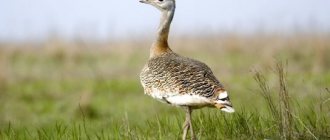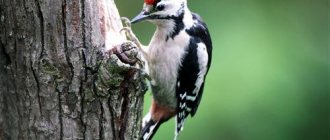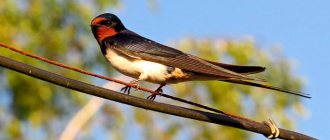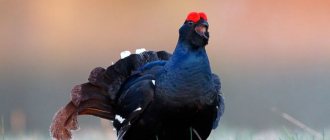- Wild animals
- >>
- Birds
The goshawk is the most studied member of the accipitridae family. This is one of the most formidable celestial predators, capable of hunting prey several times larger than its own size. The goshawk was first described and classified in the mid-18th century, but people have known this bird since ancient times and domesticated it for hawk hunting.
Origin of the species and description
Photo: Goshawk
The species of goshawk is objectively considered one of the most ancient on the planet. These birds existed in ancient times. Hawks were often considered messengers of the gods, and in Ancient Egypt there was a god with the head of this bird. The Slavs also revered the hawk and placed images of the bird on shields and coats of arms. The domestication of hawks and hunting with these birds dates back more than two thousand years.
Video: Goshawk
The goshawk is one of the largest feathered predators. The size of a male hawk ranges from 50 to 55 centimeters, weight reaches 1.2 kilograms. Females are much larger. The size of an adult can reach 70 centimeters and a weight of 2 kilograms. The wingspan of a hawk is between 1.2-1.5 meters.
Interesting fact: Thanks to the huge wingspan, the hawk can calmly glide in rising air currents and look out for suitable prey for tens of minutes, maintaining flight without any effort.
The winged predator is strongly built, has a small elongated head and a short but mobile neck. One of the specific features of the hawk is the presence of “feather pants”, which are not found in small breeds of birds of prey. The bird is covered with dense gray plumage and only the lower feathers have a light or white tint, making the bird elegant and memorable.
Interesting fact: The color of a hawk's feathers depends on its territorial location. Birds living in the northern regions have thicker and lighter plumage, while the hawks of the Caucasus Mountains, on the contrary, have dark plumage.
Interesting Facts
Goshawk preparing to land
- The name “hawk” comes from the Old Church Slavonic language and consists of two syllables, one of which means “speed”, and the second means “pockmarked, motley”. The transversely variegated pattern on the chest of these predators is also called “hawk-like.”
- The goshawk has been used in falconry since ancient times. In pursuit of prey, the terrain and vegetation do not matter to this bird. Since the predator pursues the prey, both in the air and in the thickets on the ground. That is why this type of bird has always been popular among hunters.
- The goshawk population is small. Today the species is classified as vulnerable and is protected by law in some countries.
Appearance and features
Photo: What a goshawk looks like
As mentioned above, the appearance of the goshawk seriously depends on the territory in which the bird lives. Let us list the main types of birds and indicate their characteristic features:
- European goshawk. This representative of the species is the largest of all goshawks. Moreover, a piquant feature of the species is that females are approximately one and a half times larger than males. The European hawk lives throughout almost the entire territory of Eurasia, North America and Morocco. Moreover, the appearance of the bird in Morocco is due to the fact that several dozen individuals were deliberately released in order to regulate the number of overproducing pigeons;
- African goshawk. It is more modest in size than the European hawk. The body length of an adult does not exceed 40 centimeters, and the weight does not exceed 500 grams. The bird has bluish feathers on its back and wings, and gray plumage on its chest;
- The African hawk is distinguished by very strong paws with powerful and tenacious claws, which allows it to catch even the smallest game. The bird lives throughout the African continent with the exception of the southern and arid regions;
- small hawk. As the name suggests, it is a medium-sized bird of prey. Its length is about 35 centimeters and its weight is about 300 grams. Despite its far from outstanding size, the bird is a very active predator and is capable of catching game twice its own weight. In its color, the small hawk does not differ from the European goshawk. The winged predator mainly lives in the northern and western regions of Africa;
- light hawk. A rather rare bird, which got its name because of its extremely unusual light color. In size and habits it is an almost complete copy of its European counterpart. There are only about 100 individuals of the white goshawk in the world and they are all found in Australia;
- red hawk. A very unusual representative of the hawk family. It is similar in size to a bird that breeds in Europe, but differs in red (or rufous) plumage. This bird is a real threat to parrots, which make up most of its diet.
The family of goshawks is quite numerous, but all birds have similar habits, differing from each other only in size and appearance.
Where does the goshawk live?
Photo: Goshawk in Russia
The natural habitat for the bird is large tracts of forest, forest-steppe and forest-tundra (when it comes to the northern regions of Russia). Even living in Australia and Africa, these birds settle on the border of the savannah or bush, preferring to stay close to large trees.
In the Russian Federation, hawks live almost throughout the entire country, from the Caucasus Mountains to Kamchatka and Sakhalin.
Interesting fact: a separate group of hawks nests in the Caucasus Mountains. In size and lifestyle, they do not differ from European individuals, but unlike them, they nest not in large trees, but in rocks. This is very rare, since they are the only hawks in the world that create nests on bare rocks.
In addition, birds live in Asia, China and Mexico. The number of individuals in these countries is small, but government authorities are taking significant measures to protect their population. In recent years, due to the reduction of their natural habitat, birds are forced to settle in close proximity to human habitation, and in some cases directly in cities.
As an example, we can cite families of goshawks that have settled in park areas inside the city. And in 2014, a pair of raptors built a nest on top of a New York skyscraper.
Now you know where the goshawk lives. Let's find out what he eats.
Population size
The remaining number of individuals can only be estimated approximately. Ornithologists involved in this matter are not always confident in their figures, fearing that the reality could be much worse. Relict forests are decreasing throughout the planet not only as a result of human activity, but also due to the increasing frequency of massive fires and unfavorable climate changes.
And for no more than five pairs of hawks to live, an area of 100,000 square meters is needed. Here is the known data on the distribution of goshawks: ⦁ up to 14 thousand individuals live in the United States of America; ⦁ on the African continent 20 thousand; ⦁ Asian countries account for no more than 35 thousand; ⦁ in the Russian Federation there are approximately 20-25 thousand birds; ⦁ in Europe there are about 4 thousand individuals.
What does a goshawk eat?
Photo: Goshawk bird
The hawk is a bird of prey and it feeds exclusively on animal food. Young birds can catch large insects, frogs and rodents, but by the time they reach sexual maturity, goshawks move on to catching other birds.
The largest part of the hawk's diet consists of:
- pigeons;
- crows;
- magpies;
- blackbirds;
- jays.
Hawks at peak physical condition can easily hunt ducks, geese, wood grouse and black grouse. It often happens that a feathered predator copes with prey that is equal to it in weight and even larger.
A short tail and powerful wings help the hawk to actively maneuver and quickly change direction of flight. If necessary, the bird even hunts between trees, catching up with hares and other small mammals. When a hawk is hungry, it will not miss the opportunity to catch a large lizard or snake basking on the rocks.
Interesting fact: The goshawk, trained as a bird of prey, is capable of attacking even moose or deer. Of course, the bird cannot cope with such large prey, but it “slows down” the animal and allows a pack of dogs to attack the prey.
Hunters try not to hunt in areas where the goshawk lives. This is due to the fact that the feathered predator scares away or destroys other birds within a diameter of several kilometers. Such a hunt will not bring results and will not bring pleasure.
Nutrition
A skillful and ruthless hunter can hunt without interruption during daylight hours; this bird has an excellent appetite. Its diet is quite varied; it can catch many mammals and rodents. We invite you to take a closer look at its menu:
- Pigeons;
- Crows;
- Proteins;
- Partridges;
- Pheasants;
- Black grouse;
- Rabbits;
- Hares;
- Blackbirds;
- Rats;
- Finches;
This is just a tiny list, it is actually much longer. All birds of this species adhere to the same tactics, so as not to waste energy chasing, they prefer to wait for the prey in ambush.
To do this, they have a special observation post where they guard their victims, or they can circle low above the ground for a long time, scaring them out of tall grass and bushes.
If he is lucky with a large prey, for example: a hare, he grabs it and flies off to a secluded place, where he will continue his bloodthirsty feast.
Features of character and lifestyle
Photo: Goshawk in flight
Almost all species of goshawks lead a sedentary lifestyle, and unless force majeure occurs, the predators live their entire lives in the same territory. The only exceptions are birds living in the northern United States of America near the Rocky Mountains. In winter, there is practically no prey in these parts, and winged predators are forced to migrate south.
The goshawk is a very fast and agile bird. She is diurnal, preferring to hunt in the early morning or during the day before the sun reaches its zenith. The bird spends the night in the nest, since its eyes are not adapted for night hunting.
Hawks are strongly attached to their territory; they try not to fly beyond its boundaries and spend their entire lives in the same nest. These birds are monogamous. They create a stable couple and remain faithful to each other throughout their lives.
As a rule, the hunting territories of a pair of hawks overlap, but do not coincide with each other. Birds are very jealous of their lands and drive out (or kill) other feathered predators that fly here.
Interesting fact: Although female hawks are larger than males, their territory is 2-3 times smaller. Males are considered the main breadwinners in the family, and for this reason their hunting grounds are larger.
In their natural habitat, hawks make nests in the thicket of the forest, on the tops of the tallest trees, at a height of up to 20 meters.
Habitat
The habitat covers the zone of boreal coniferous, mixed and deciduous deciduous forests in the northern hemisphere in Eurasia and North America. Small populations remain in the north-west of the African continent and the islands of the Mediterranean, and the largest in Finland and Russia from the Kola Peninsula to Kamchatka.
In general, goshawks avoid regions with hot climates. The southern border of the range passes through Greece, Asia Minor and northern Iran.
In the USA and Central Europe, birds often settle in cities where there are forests, parks and other green spaces. This trend has appeared since the 60s of the last century. They are also found in mountainous areas at altitudes up to 3000 m above sea level.
To date, 10 subspecies , two of which live in Japan. The nominate subspecies is found in Central and Northern Europe, western Russia up to the Pyrenees and the southern regions of the Alps and Carpathians.
Social structure and reproduction
Photo: Goshawk in Belarus
The male begins to court the female from the end of April to the beginning of June. Almost immediately after the courtship period, the couple begins to build a nest, and both the male and the female participate in this process.
Nest construction begins a couple of months before the eggs are laid and lasts about two weeks. During this time, the birds build a large nest (about a meter in diameter). Dry branches, tree bark, pine needles and tree shoots are used for construction.
Typically, a goshawk nest contains 2-3 eggs. They are almost the same in size as chickens, but have a bluish tint and are rough to the touch. Hatching of the eggs lasts 30-35 days and the female sits on the eggs. At this time, the male hunts and supplies his girlfriend with prey.
After the males are born, the female remains with them in the nest for a whole month. Throughout this period, the male hunts with redoubled energy and supplies the female and all the chicks with food.
After a month, the young begin to fly, but their parents still feed them, teaching them to hunt. Only three months after leaving the nest, the chicks become completely independent and leave their parents. Birds reach sexual maturity within a year.
Under natural conditions, the goshawk lives for about 14-15 years, but in nature reserves with good nutrition and timely treatment, birds can live up to 30 years.
Lifestyle
Most populations lead a sedentary lifestyle and, as a rule, adhere to one territory throughout their lives. The only migratory population is considered to be that which nests in the north and northwest of North America - they migrate south for the winter.
Goshawks strictly adhere to their territory, and the nesting pair clearly demonstrates aerial pirouettes before and during nest construction. If anyone invades their territory, the couple will fiercely defend it. The individual territory of males is, as a rule, larger than that of females. Territories may overlap among different individuals, with the exception of the nesting area.
During nesting, the individual territory as a whole ranges from 570 to 3500 hectares.
Like other hawks, goshawks communicate with each other using sound signals , emitting a high-pitched, ringing squawk. Their communication is especially noticeable during nesting, when both the male and the female make the same vibrating sounds, only the female’s voice is lower and louder.
Nesting
They prefer to make nests in a forest consisting of old and tall trees with average illumination and small edges nearby for hunting.
The nests are located at a height of 12-20 m and can be used by different pairs for up to 60 years. The building materials are branches, brushwood and tree bark. The outer side of the nest is decorated with spruce or pine branches. The inner part has a diameter of 60-80 cm and a height of 40-50 cm.
A family nest used for several years clearly increases in size over time. The inside is lined with dry grass and soft feathers.
Nutrition
Goshawks are birds of prey that hunt birds, mammals, invertebrates, medium and large reptiles. The prey can be up to half the weight of the predator.
Their diet includes lagomorphs, squirrels, voles, lemmings, pigeons, thrushes, crows, various galliformes and anseriformes. They often successfully hunt medium-sized birds of prey, including sparrowhawks, common kestrels and kites. Their prey is often young ospreys and lesser spotted eagles.
Goshawks attack their victims in low flight on the surface of the soil or from ambush with a short and swift throw.
Trees, bushes and hedges, as well as house roofs and telegraph poles, are used as observation points. Much less often, predators look for potential prey by flying in circles or walking directly on the ground. The latter method is used for hunting moles and nesting ducks.
Grabbing victims from trees, ground and air is ensured by sharp and long claws that penetrate deeply into the body of the animal.
In winter, when food is scarce, predators do not disdain carrion, and in summer they diversify their menu with reptiles. They feed on fish, shellfish, worms and insects only in extreme cases.
Reproduction
Sexual maturity in this bird occurs at the age of about 10 months. Goshawks breed once a year. In early spring, young birds begin searching for a partner, with whom they most often spend their entire lives.
The female performs the mating dances first. Then both partners demonstrate aerobatics. They, slowly flapping their outstretched wings, fly around the nesting sites, rise high up and, folding their wings, fall down. This paired birds repeat many times and then disappear into the forest where mating occurs.
Birds use the same nest for several years in a row, updating it annually. The female lays eggs with an interval of 2-3 days. Chicks usually hatch after 5 weeks.
For the first 9-14 days, the female does not leave the hatched chicks, otherwise they will freeze.
Concerns about feeding the family fall entirely on the shoulders of the male. In addition, in this species, only the mother knows the art of tearing food into pieces and dividing it into equal portions. The chicks grow quickly and are covered with thick, warm down that protects them from hypothermia.
The hatched chicks remain in the nest for 34-35 days , after which they begin to move to neighboring branches of the same tree. The chicks begin to fledge at 45-50 days , but remain dependent on their parents for about 3 more weeks.
Feeling strong, the chicks fly off in search of their own home site. It is usually located no more than 30 km from the parental nest.
Natural enemies of the goshawk
Photo: What a goshawk looks like
By and large, the goshawk does not have many natural enemies, since these birds are at the top of the food chain of winged predators. She herself is a natural enemy for many birds and small forest game.
However, foxes can pose the greatest danger to young animals. These are one of the most intelligent forest predators who are capable of guarding prey for hours, and if a young bird gapes, the fox is quite capable of attacking a hawk.
At night, hawks can be threatened by owls and eagle owls. Goshawks do not see well in the dark, which is what owls, which are ideal nocturnal predators, take advantage of. They may well attack chicks at night without fear of retaliation from adult hawks.
Other birds of prey, whose size exceeds the size of a hawk, can also pose a tangible threat. For example, in the United States, hawks and eagles live in close proximity, and eagles, as larger birds, dominate over hawks and do not at all disdain hunting them.
In addition, if there is not enough game, hawks can engage in cannibalism and eat smaller and weaker relatives or their broods. However, the greatest danger to goshawks comes from people who hunt birds for beautiful plumage or to make beautiful and spectacular stuffed animals.
